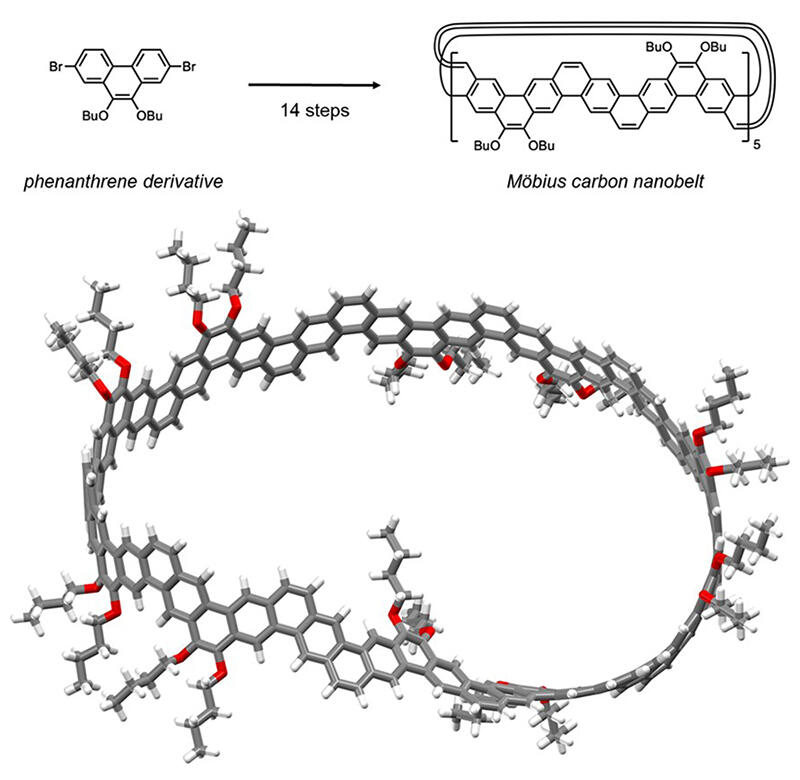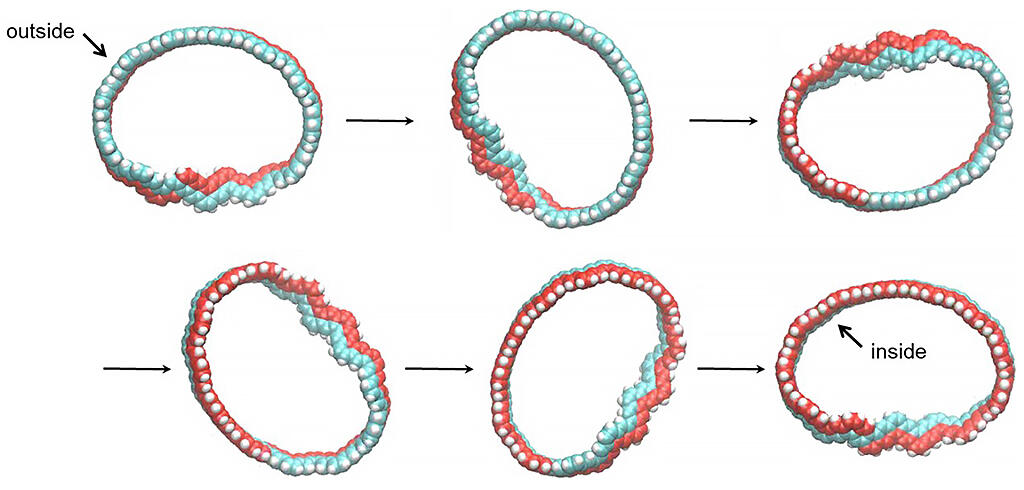A research group led by Professor Kenichiro Itami of the Institute of Transformative Bio-Molecules (ITbM), Nagoya University, in collaboration with Associate Professor Yasutomo Segawa of the Institute for Molecular Science, has succeeded, for the first time in the world, in synthesizing a Möbius ring of carbon called a "Möbius carbon nanobelt." The group quantitatively analyzed the huge strain derived from the twisted structure of belt-like carbon nanobelts and used a rational strategy to synthesize the belt through organic synthetic chemistry. Analysis of the synthesized Möbius carbon nanobelt revealed that it has unique dynamic behavior and optical properties derived from the topology of the Möbius belt. It is a groundbreaking achievement that paves the way for the development of new nanocarbon materials with complex geometric structures. The research group's findings were published in Nature Synthesis online.
To explore the field of nanocarbons, there is a need for a method to synthesize materials with nanometer-size repeating structures, with atomic-level precision. As an important step in this direction, molecular nanocarbon science, which uses synthetic organic chemistry to synthesize molecules that serve as nanocarbon substructures, has been actively studied in recent years. However, the molecular nanocarbons synthesized up to now have been geometrically simple structures, such as rings or belts. The synthesis of unexplored nanocarbons with complex geometric structures predicted by theoretical chemistry requires the development of new methods to synthesize molecular nanocarbons with more complex and geometric features.
The research group first conducted a quantitative analysis of the strain energy on Möbius carbon nanobelts through quantum chemical calculations using a supercomputer at the National Institutes of Natural Sciences. It is known that the smaller the ring-shaped molecular nanocarbons are, the fewer synthesis steps that are needed, but this means that reaction becomes more difficult. Carbon nanobelts with 12 benzene rings have been synthesized as the smallest molecules to date, but it was estimated that Möbius carbon nanobelts require at least 38 benzene rings because the strain is further increased by their twisting structure.

Provided by Yasutomo Segawa, Institute for Molecular Science, National Institutes of Natural Sciences.
The research group was able to synthesize a Möbius carbon nanobelt based on their calculations. In 2017 they successfully synthesized carbon nanobelts and have now developed a new method for the asymmetric modification of phenanthrene, a commercially available organic molecule, which enabled a synthetic method to sequentially extend carbon chains. They succeeded in synthesizing a Möbius carbon nanobelt consisting of 50 benzene rings through a total of 14 organic synthesis steps using previously reported molecules. A similar method was also attempted to synthesize a Möbius carbon nanobelt consisting of 30 benzene rings, but they were unable to obtain the target material, suggesting that the computational science estimation used might be an option in the future.
The synthesized Möbius carbon nanobelt has been found to have unique properties derived from the shape of the Möbius belt. NMR measurements show that the twists present in the Möbius carbon nanobelt structure propagate quickly throughout the molecule in solution. Molecular dynamics simulations conducted by Specially Appointed Associate Professor Yuh Hijikata and Assistant Professor Jenny Pirillo at the Institute for Chemical Reaction Design and Discovery, Hokkaido University, reproduced this property, confirming that the molecule is indistinguishable between its two sides despite its belt-like shape. Möbius rings are also known to have chirality, and in the developed Möbius carbon nanobelts the topological chirality arising from the Möbius structure was experimentally confirmed.

Provided by Yasutomo Segawa, Institute for Molecular Science, National Institutes of Natural Sciences.
These results provide an innovative method for the synthesis of molecular nanocarbons with complex topologies and are expected to be applied to the precise construction of various complex and strained nanocarbon structures in the future, which will contribute to the development of synthetic organic chemistry and materials science.
This article has been translated by JST with permission from The Science News Ltd.(https://sci-news.co.jp/). Unauthorized reproduction of the article and photographs is prohibited.




